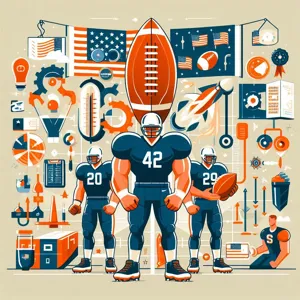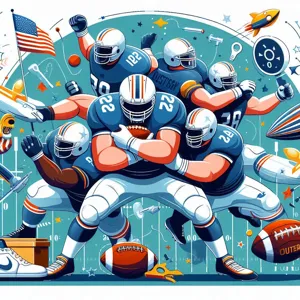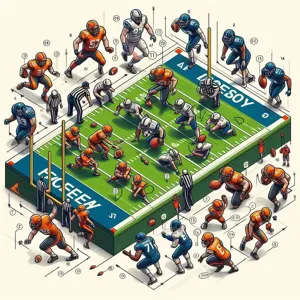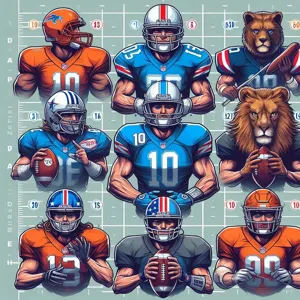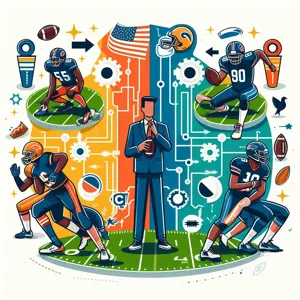In the world of soccer, talent and skill are undeniably vital, but the true magic often lies in something less tangible: team chemistry.
Picture a finely tuned engine, where every part works harmoniously to propel the vehicle forward. Similarly, when players share a deep understanding, mutual trust, and a cohesive bond, their synergy can elevate their performance on the pitch to extraordinary levels. From the precision of passing to the intuition behind positioning, team chemistry transforms a group of individuals into a united force, capable of overcoming challenges and achieving success. In this blog post, we’ll delve into the secret sauce that is team chemistry, exploring how it impacts communication, enhances performance, and fosters a winning mindset. Join us as we uncover the intricate dynamics that make teamwork not just important, but essential for any soccer team aspiring to reach the pinnacle of success.
1. Introduction to Team Chemistry in Soccer

In the world of soccer, where individual talent often dazzles fans and players alike, the true magic lies in the unbreakable bond formed within a team. Team chemistry is more than just a buzzword; it’s the secret sauce that can elevate a group of skilled players into a cohesive unit capable of achieving greatness on the pitch. When players harmonize their skills, instincts, and strategies, they create a synergy that transcends mere tactical execution.
Picture this: a striker who knows exactly when to make that crucial run, a midfielder who can anticipate the next move with pinpoint accuracy, and defenders who instinctively cover for each other. This level of understanding doesn’t come from mere practice; it is born from trust, communication, and shared experiences. Team chemistry fosters a sense of camaraderie, allowing players to build relationships that enhance not only their performance but also their enjoyment of the game.
In this introduction, we will delve into the foundational elements of team chemistry—communication, trust, and shared goals—and explore how these components contribute to a team’s success. As we unravel the intricate dynamics of teamwork, we will reveal why cultivating chemistry is not just beneficial but essential for any soccer team striving for victory. Whether you’re a coach, a player, or an avid fan, understanding the importance of team chemistry will provide deeper insights into what makes the beautiful game so compelling. Join us as we explore the profound impact of unity on the field and discover how it can turn a good team into a great one.
2. Defining Team Chemistry: What Does It Mean?
Team chemistry in soccer is more than just a buzzword tossed around in post-match interviews; it’s the invisible thread that binds players together, fostering a cohesive unit capable of achieving greatness on the field. At its core, team chemistry refers to the synergy among players, the understanding that transcends verbal communication, and the ability to anticipate each other’s moves as if they were reading from the same script. It’s about trust, respect, and shared goals — elements that create a supportive environment where individual talents can shine while contributing to the collective purpose.
In practical terms, team chemistry manifests in seamless passing, intuitive positioning, and an unspoken ability to cover for one another during tense moments of play. A squad that communicates effectively will often outmaneuver its opponents, not just through skill but through a collective mindset that prioritizes team success over personal glory. This chemistry is cultivated through shared experiences, whether it’s grueling training sessions, team-building activities, or simply spending time together off the pitch.
When players understand each other’s strengths and weaknesses, they can adapt their styles to complement one another, leading to enhanced performance. A striker might know that a midfielder will always make a late run into the box, while defenders might instinctively recognize when to push up or hold their line, based on their fellow players’ movements. This level of understanding takes time, patience, and effort to develop, but the payoff is significant: teams with strong chemistry not only play better but also foster a sense of camaraderie that can be crucial during high-pressure situations.
Ultimately, defining team chemistry is about recognizing that success in soccer is not solely determined by individual talent but by the harmonious interplay of a group of players who are committed to each other and their shared aspirations. When teams embody this spirit, they transform into a formidable force, capable of overcoming challenges and achieving remarkable feats on the pitch.
3. The Role of Communication in Building Chemistry

Communication is the heartbeat of any successful soccer team, serving as the vital link that fosters chemistry both on and off the pitch. It transcends mere verbal exchanges; it encompasses body language, nonverbal cues, and the unspoken understanding that develops when players spend time together. Effective communication ensures that players are aligned in their objectives, aware of each other’s movements, and prepared to respond to the fluid dynamics of the game.
On the field, this means more than just shouting tactical instructions; it involves players anticipating each other’s intentions. For example, a well-timed pass that connects with a teammate’s run is often the result of prior discussions and an established rapport. Teams that excel in communication tend to exhibit a level of synergy that is palpable, with players instinctively knowing when to make a run, when to drop back, or how to create space.
Off the field, building a culture of open dialogue and trust can significantly enhance team chemistry. Regular team meetings, social gatherings, and training sessions that encourage feedback help players feel valued and understood. When players can express themselves freely, they develop a stronger bond, which translates into more cohesive play during matches.
In essence, prioritizing communication not only sharpens tactical understanding but also cultivates a sense of unity and purpose within the squad. Teams that communicate effectively are better equipped to navigate the challenges of a season, leading to enhanced performance and, ultimately, greater success on the field.
4. Trust: The Foundation of Effective Teamwork
Trust is the bedrock upon which effective teamwork is built, especially in the high-stakes world of soccer. When players trust one another, they can operate with a level of confidence that transcends individual skill. Trust fosters open communication, allowing players to share thoughts, strategies, and feedback without fear of judgment. This communication is vital on the pitch, where split-second decisions can determine the outcome of a match.
Consider the moment a midfielder receives the ball under pressure. If they trust their teammates to make the right runs and positions, they can focus on executing their vision rather than second-guessing whether someone will be in the right spot. This seamless interplay creates a dynamic flow, where players anticipate each other’s movements and synchronize their actions.
Moreover, trust cultivates an environment where players feel safe to take risks. In soccer, taking risks can lead to breathtaking plays, but only if players believe in one another’s abilities. A player who knows their teammates will support them, whether through an encouraging word after a mistake or a strategic cover on defense, is more likely to attempt that audacious pass or daring dribble that could change the course of a game.
Building trust takes time and requires shared experiences—both on and off the field. Teams that engage in team-building activities, share meals, or simply spend time together outside of training often find that these bonds translate into greater cohesion during matches. This sense of unity not only enhances performance but also creates a positive team culture where players are motivated to push each other to achieve collective goals.
In essence, trust is the invisible thread that weaves together the fabric of a successful soccer team. It transforms a group of talented individuals into a cohesive unit capable of executing complex plays and overcoming adversity. Teams that prioritize trust will find themselves not only winning more matches but also enjoying the journey together, fostering a sense of camaraderie that lasts beyond the final whistle.
5. Shared Goals: Aligning Individual Aspirations for Success

In the world of soccer, individual talent is essential, but it is the alignment of those talents towards shared goals that transforms a group of players into a cohesive, high-performing team. When each player understands not only their role but also how their aspirations contribute to the team’s overall objectives, the result is a powerful synergy that can propel a team to success.
Imagine a squad where every player harbors personal ambitions—be it scoring goals, earning a starting position, or showcasing their skills on a larger stage. While these individual aspirations are important, they can often lead to conflicts if left unchecked. That’s why it’s vital for coaches and team leaders to foster an environment where these personal goals align with the team’s mission.
Take, for instance, a team that sets a collective goal of winning the league championship. Each player should recognize how their individual efforts—be it defensive prowess, midfield creativity, or striking ability—feed into that overarching aim. When players clearly see how their success contributes to the team’s achievements, they become more invested in each other’s performance. This alignment not only enhances collaboration on the field but also cultivates a deeper sense of camaraderie off it, where players support and motivate one another to reach their full potential.
Regular team meetings and open communication channels can be incredibly effective in this process. By discussing personal goals and intertwining them with team objectives, players can create a shared vision that resonates with everyone. When a player scores a goal, it is not just a personal triumph; it is a step closer to the team’s shared ambition, fostering a culture of unity that is vital for success.
Ultimately, when individual aspirations and team objectives are harmoniously aligned, players not only perform better but also find greater satisfaction in their roles. This shared commitment to a common goal creates a winning mentality that can drive a team through the toughest of challenges, making it a critical ingredient in the recipe for soccer success.
6. The Impact of Relationships on Performance
The Impact of Relationships on Performance
In the world of soccer, where split-second decisions can make or break a game, the relationships among players are far more than mere camaraderie; they are the bedrock of performance on the field. A team that shares strong interpersonal bonds communicates effectively, anticipates each other’s moves, and plays with a sense of unity that can be palpable to both teammates and spectators alike.
When players trust one another, they become more willing to take calculated risks, knowing that their teammates have their backs. This trust is often cultivated through shared experiences, whether it’s grueling training sessions, team-building retreats, or simply spending time together off the field. The more players understand each other’s strengths, weaknesses, and playing styles, the better they can coordinate their efforts during a match. For instance, a forward who knows their teammate’s tendencies can time runs with precision, creating scoring opportunities that wouldn’t have existed otherwise.
Moreover, positive relationships foster a culture of accountability. When players feel a genuine connection with their teammates, they are more likely to hold each other accountable for their roles and responsibilities. This sense of accountability not only elevates individual performance but also reinforces team discipline, leading to a more cohesive unit that operates seamlessly under pressure.
Conversely, a lack of strong relationships can lead to misunderstandings, miscommunications, and conflict on the pitch. Players may hesitate to pass the ball or make bold moves if they doubt their teammates’ abilities or commitment. Such uncertainty can hinder the team’s overall performance, creating a cycle of frustration and missed opportunities.
Ultimately, the impact of relationships on performance in soccer cannot be overstated. Teams that invest in building strong, trusting relationships among players invariably find themselves reaping the rewards in terms of improved synergy, heightened morale, and, ultimately, greater success on the field. Whether through team bonding activities or promoting open communication, prioritizing these relationships is the secret ingredient that can elevate a good team into a great one.
7. How Team Chemistry Affects On-Field Decision Making

Team chemistry is often the unsung hero of on-field success in soccer, influencing everything from player positioning to the execution of complex plays. When players share a deep understanding and trust in one another, the game transforms from a series of isolated actions into a fluid, harmonious exchange of skills and tactics. This synergy allows players to anticipate each other’s movements, enabling them to make split-second decisions that can turn the tide of a match.
Imagine a well-coordinated backline, where defenders instinctively know when to press forward or hold their ground, based on a teammate’s body language. This level of awareness stems from countless hours spent training together, building rapport not only as teammates but as friends. When players are in sync, they communicate more effectively, often using mere glances or subtle gestures to convey intentions without uttering a word. This invisible thread of connection can lead to seamless passing sequences, clever overlaps, and, ultimately, scoring opportunities that might not arise in a less cohesive unit.
Conversely, a lack of chemistry can lead to confusion and hesitation on the field. Players who do not trust one another may second-guess decisions, leading to disjointed plays and missed opportunities. For instance, a forward may make a run toward the goal, only to find that the midfielder, unsure of the forward’s intent, hesitates to deliver the ball. These moments of uncertainty can be detrimental, especially in high-stakes situations where every second counts.
In high-pressure scenarios, such as a championship match or a crucial playoff game, the bonds forged through team chemistry become even more critical. Players who have developed a strong sense of camaraderie are more likely to remain calm under pressure, leaning on each other for support and motivation. This shared mentality not only enhances performance but also fosters resilience, allowing the team to face adversity with a united front.
Ultimately, the interplay of individual skills and collective understanding is what makes soccer a beautiful game. Teams that invest in building chemistry off the field—through team-building activities, open communication, and a supportive environment—will often find that their on-field decision-making becomes sharper, more instinctive, and effective. In the end, chemistry isn’t just an added bonus; it’s the secret sauce that can elevate a good team into a great one.
8. The Importance of Team Dynamics and Roles
When it comes to soccer, the magic often lies not just in individual talent but in the intricate web of team dynamics and clearly defined roles. A well-coordinated team operates like a finely tuned machine, where each player understands their responsibilities and how they fit into the larger picture. This synergy fosters trust and communication, allowing players to anticipate each other’s movements and decisions on the field.
Understanding team dynamics begins with recognizing the unique strengths and weaknesses of each player. A strong forward may excel at finishing plays, but if they aren’t supported by a creative midfielder who can deliver precise passes, their potential remains untapped. Similarly, a solid defense requires players who not only possess individual skills but also work in unison to thwart attacks. Each player must be aware of their role—whether it’s as a leader on the field, a strategist, or a reliable supporter—ensuring that every position is filled with intention and purpose.
Moreover, fostering good team dynamics goes beyond tactical formations. It encompasses building relationships both on and off the field. Teams that engage in team-building exercises, social events, or even shared training sessions develop a camaraderie that translates into better on-field performance. When players trust one another, they are more likely to take calculated risks, make daring plays, and support each other in challenging moments. This bond not only enhances performance but also nurtures resilience, as players are more inclined to lift each other during tough times.
In the end, the importance of team dynamics and defined roles cannot be overstated. A cohesive unit that understands and embraces its collective identity will always have the upper hand in achieving success, regardless of the individual skill levels present within the squad. After all, soccer is not just a game of goals; it’s a symphony of collaboration, where every note—every player—counts towards the beautiful melody of victory.
9. Case Studies: Successful Teams with Strong Chemistry
When delving into the world of soccer, it’s astonishing to see how many successful teams have thrived not just on talent alone, but on the strength of their internal chemistry. Let’s explore a few standout case studies that illustrate this vital ingredient for success.
**FC Barcelona (2008-2012)**
Under the management of Pep Guardiola, FC Barcelona reached the pinnacle of world soccer, dominating both domestic and international competitions. What set this team apart was not just its roster of superstars like Lionel Messi, Xavi, and Iniesta, but the profound understanding and trust among the players. They played a style of soccer known as “tiki-taka,” characterized by short, quick passes and movement. This required an intimate knowledge of each other’s game, something that was cultivated through countless hours of training and on-field experience together. The chemistry allowed them to anticipate each other’s movements, creating a seamless flow that bewildered opponents and led to numerous titles, including two UEFA Champions League trophies.
**Leicester City (2015-2016)**
The story of Leicester City’s fairytale Premier League victory in the 2015-2016 season is often recounted as one of the greatest underdog triumphs in sports history. However, beyond the tactical genius of manager Claudio Ranieri and the brilliance of players like Riyad Mahrez and Jamie Vardy, the real secret to their success lay in the unity and camaraderie within the squad. The players, many of whom had been overlooked by bigger clubs, shared a common goal and a deep sense of loyalty to one another. Their chemistry was evident in their on-field communication and off-field relationships, fostering an environment where every player felt valued and motivated. This strong bond translated into performances filled with resilience and passion, propelling them to an unexpected league title.
**Germany National Team (2014)**
The German national team’s journey to victory in the 2014 FIFA World Cup epitomizes the importance of team chemistry in achieving greatness. The squad, featuring talents like Thomas Müller, Mesut Özil, and Mario Götze, displayed remarkable coordination and mutual understanding. Their chemistry was not simply a product of skill—many of these players had grown up together in youth setups and shared a common playing philosophy instilled by their coaches. The team’s ability to work together under pressure was evident in their historic 7-1 thrashing of Brazil in the semifinals. Their seamless interplay and collective spirit propelled them through the tournament, culminating in a well-deserved championship.
These case studies reveal that success in soccer transcends mere talent; it’s about how well players connect and collaborate on and off the field. Strong chemistry can turn a group of individuals into a cohesive unit, capable of achieving remarkable feats and overcoming adversity. In a sport where every pass, every run, and every decision can be the difference between victory and defeat, nurturing team chemistry is indeed the secret sauce for success.
10. Strategies for Fostering Team Chemistry
Fostering team chemistry is not just about building camaraderie; it’s about creating a cohesive unit that plays seamlessly on the field. Here are several effective strategies to enhance chemistry within your soccer team, ensuring that every player feels connected and empowered to contribute to the collective goal.
**1. Team-Building Activities**: Organize regular team-building exercises that go beyond the soccer pitch. Activities such as trust falls, ropes courses, or even casual outings can help break down barriers and promote openness among players. These shared experiences build bonds that translate into better communication and understanding during matches.
**2. Encourage Open Communication**: Establish an environment where players feel comfortable sharing their thoughts and concerns. Regular meetings or informal discussions can be invaluable, allowing teammates to express ideas, provide feedback, and resolve conflicts. This transparency fosters trust and encourages players to support one another.
**3. Create Shared Goals**: Set collective objectives for your team, whether it’s winning the league, improving individual skills, or enhancing team defense. When everyone is working toward the same vision, players feel a sense of ownership and responsibility towards one another. Celebrate milestones together to reinforce this sense of unity.
**4. Promote Inclusivity**: Ensure that all players feel included, regardless of their skill level. Encourage stronger players to mentor those who may be less experienced. This not only helps improve individual capabilities but also cultivates an atmosphere of support and respect, vital for a harmonious team dynamic.
**5. Regular Feedback and Recognition**: Foster a culture of constructive feedback and appreciation. Recognizing individual contributions, even in small ways, can boost morale and encourage players to strive for excellence. Implementing peer recognition systems, where teammates acknowledge each other’s efforts, can also enhance bonds.
**6. Develop Rituals and Traditions**: Create team rituals or traditions that instill a sense of belonging. It could be a unique pre-game chant, a celebratory dance after scoring, or a post-match dinner. These traditions build a sense of identity and pride among players, making them feel like integral parts of the team.
By implementing these strategies, you not only enhance team chemistry but also pave the way for a successful soccer season. A team that understands and supports one another is a team that can overcome challenges, celebrate victories, and ultimately achieve greatness together.
11. The Role of Leadership in Enhancing Team Cohesion
In the world of soccer, where skill and strategy often take center stage, the undercurrent that truly drives a team toward success is the intangible quality of team chemistry. At the heart of this chemistry lies effective leadership, which plays a pivotal role in enhancing team cohesion. A good leader fosters an environment where players not only respect one another’s abilities but also feel valued as integral parts of the collective unit.
Leadership in soccer transcends the traditional notion of authority; it embodies the ability to inspire, communicate, and unify a diverse group of individuals with varying personalities and backgrounds. A captain who leads by example, demonstrating dedication both on and off the field, can instill a sense of purpose and commitment in teammates. Moreover, effective leaders are adept at recognizing and harnessing the unique strengths of each player, creating a balanced team dynamic that encourages collaboration over competition.
Coaching also plays an essential role in this equation. A coach who prioritizes open communication fosters a culture where players feel comfortable expressing their thoughts and concerns. This transparency not only builds trust but also helps in resolving conflicts before they escalate, ensuring that the focus remains on the game and the goals at hand.
Moreover, leaders who actively promote team-building activities, whether through training exercises or social events, can significantly enhance relationships among players. These shared experiences deepen bonds, allowing players to understand one another’s playing styles, work ethics, and emotional triggers. When players feel connected, they develop a sense of accountability to their teammates, driving them to perform at their best for the collective good.
In essence, the role of leadership in enhancing team cohesion cannot be overstated. It is the glue that binds individual talents into a cohesive unit, enabling them to work collaboratively toward a common goal. As any successful soccer team will attest, when players trust their leaders and each other, magic happens on the field, turning potential into performance and dreams into victories.
12. Overcoming Challenges to Team Chemistry
Team chemistry isn’t just a luxury in soccer; it’s a necessity. However, cultivating that chemistry is not always a straightforward endeavor. Teams inevitably face challenges that can disrupt the delicate balance of collaboration, trust, and understanding among players. Recognizing and addressing these hurdles is crucial for maintaining a cohesive unit on the field.
One of the most common challenges is dealing with diverse personalities. Each player, with their unique background and temperament, brings different strengths and weaknesses to the team dynamic. A star player might struggle with ego, while a newcomer may struggle with self-confidence. Coaches must foster an environment of open communication, where players feel safe expressing their thoughts and emotions. Team-building exercises and regular check-ins can help bridge gaps, encouraging empathy and camaraderie.
Injuries can also pose a significant challenge to team chemistry. When key players are sidelined, it can lead to frustration and uncertainty among teammates. The remaining players need to adapt to new roles and responsibilities, which can disrupt the established synergy. This is where strong leadership comes into play. Captains and coaches should emphasize the importance of resilience and adaptability, reinforcing the idea that success is a collective effort, regardless of individual circumstances.
Another challenge arises from differing competitive mindsets. Some players thrive on competition and may unintentionally create a rift by prioritizing personal accolades over team success. It’s essential for the coaching staff to instill a culture of unity, where individual achievements are celebrated as part of a collective victory. Regular team meetings focused on shared goals and collective success can help realign priorities and strengthen the bond among players.
Finally, external pressures, such as media scrutiny or fan expectations, can weigh heavily on a team. Players may feel the need to perform at their peak, leading to stress and anxiety that can fracture team dynamics. To combat this, creating a supportive atmosphere is vital. Encouraging players to lift each other up during challenging times fosters a sense of belonging and reinforces the idea that they are in it together, no matter the external pressures.
In conclusion, overcoming challenges to team chemistry requires awareness, patience, and a proactive approach. By addressing personality clashes, managing injuries, aligning competitive mindsets, and mitigating external pressures, teams can cultivate a strong, united front that is poised for success on the soccer field. When players trust each other and work harmoniously, the magic of teamwork can transform their game and lead to remarkable achievements.
13. Measuring Team Chemistry: Tools and Techniques
Measuring team chemistry in soccer can be complex, as it involves both quantitative metrics and qualitative insights. However, with the right tools and techniques, coaches and analysts can gain a clearer understanding of how well players are syncing on the field.
One effective approach is to utilize performance analytics software, which tracks player movements, passes, and interactions during matches. This data can reveal patterns of play that highlight how well teammates communicate and collaborate. For instance, a high number of successful passes between two players can indicate a strong on-field rapport, suggesting that they understand each other’s movements and playing styles. Tools like Opta or Hudl provide comprehensive statistics that can be analyzed post-game to assess these dynamics.
In addition to data analysis, qualitative measures can provide deeper insights into team chemistry. Conducting regular team-building activities, both on and off the field, can foster relationships and trust among players. Surveys and feedback sessions can help gauge players’ feelings about their relationships with teammates and how these relationships affect their performance. Questions might address communication preferences, perceived support during games, and overall satisfaction with team dynamics.
Furthermore, observing practice sessions can yield valuable information. Coaches should pay attention to how players interact during drills, how they celebrate successes, and how they handle mistakes. Are teammates quick to encourage each other after a missed shot, or does frustration linger? These subtle cues often speak volumes about the underlying chemistry of the team.
Combining these quantitative and qualitative techniques will provide a holistic view of team chemistry. By regularly measuring this crucial element, coaches can make informed decisions to enhance their squad’s harmony and performance, ultimately leading to greater success on the pitch.
14. The Long-term Benefits of Strong Team Chemistry
When it comes to soccer, team chemistry isn’t just a fleeting advantage; it’s a crucial element that yields long-term benefits that can define a club’s success over the years. Strong team chemistry fosters an environment where players can trust one another implicitly, enhancing on-field communication and decision-making. This synergy translates into smoother play, as teammates develop an innate understanding of each other’s movements, preferences, and playing styles.
A cohesive team is more resilient in facing challenges, whether it’s overcoming a tough opponent or navigating the rigors of a long season. Players who are comfortable with one another are more willing to offer constructive feedback, take risks, and even hold each other accountable, which elevates overall performance. Additionally, strong chemistry can attract new talent; players want to join a team where collaboration thrives and success is a collective goal.
Off the pitch, this camaraderie fosters a positive club culture, leading to higher morale and motivation. When players feel connected to their teammates, they are more likely to stay committed to the team, reducing turnover rates and creating a stable core group that can grow and evolve together. In the long run, this stability allows for the development of intricate plays and strategies that require time and trust to perfect.
Moreover, the ripple effects of strong team chemistry extend to the fans and community. A united team that plays with passion and harmony can inspire a loyal fan base, enhancing attendance and support during matches. This connection between the team and its supporters can create an electric atmosphere both on and off the field, reinforcing the team’s identity and legacy.
In essence, the long-term benefits of strong team chemistry are multi-faceted. It not only propels a team toward immediate victories but also lays the groundwork for sustained success and a vibrant club culture that can thrive for generations. Investing in team chemistry is, therefore, not just an option; it’s a fundamental strategy for anyone serious about achieving greatness in soccer.
15. Conclusion: Embracing the Secret Sauce for Soccer Success
In the high-stakes world of soccer, where talent and tactics often take center stage, one element consistently emerges as the unsung hero: team chemistry. As we’ve explored throughout this post, the bonds formed between players, the mutual understanding on the field, and the shared commitment to a common goal all contribute to a team’s success in ways that cannot be quantified by statistics alone.
Embracing this “secret sauce” is essential for any coach, player, or organization aiming to elevate their game. It requires intentional effort, open communication, and a culture that fosters collaboration both on and off the pitch. When players genuinely connect with one another, they develop an intuitive sense of each other’s movements, strengths, and weaknesses, transforming the dynamics of gameplay.
Moreover, a cohesive team environment cultivates resilience, allowing players to rally together during challenging moments and celebrate victories as one formidable unit. This sense of unity can be the difference between a good team and a great one. As you move forward, remember that while skill and strategy are vital, it’s the chemistry that truly ignites passion, drives performance, and propels teams to greatness.
In conclusion, prioritize nurturing relationships, fostering inclusivity, and creating a supportive atmosphere. When you invest in team chemistry, you aren’t just building a squad; you’re crafting a legacy of success that can withstand the test of time. Embrace this secret sauce, and watch as your soccer team flourishes both on the field and in the hearts of fans.
In conclusion, fostering team chemistry is indeed the secret sauce that can elevate a soccer team from good to great. As we’ve explored throughout this post, the bonds formed both on and off the field translate directly into improved communication, trust, and ultimately, performance during matches. By prioritizing relationship-building activities, open communication, and a shared vision, coaches and players alike can create an environment that nurtures collaboration and resilience. Remember, a team with strong chemistry is not just a group of individuals; it’s a united force capable of overcoming challenges and achieving remarkable success. So, take these insights, invest in your team’s dynamics, and watch as the synergy transforms your game. Here’s to forging connections that lead to triumph on the pitch!














